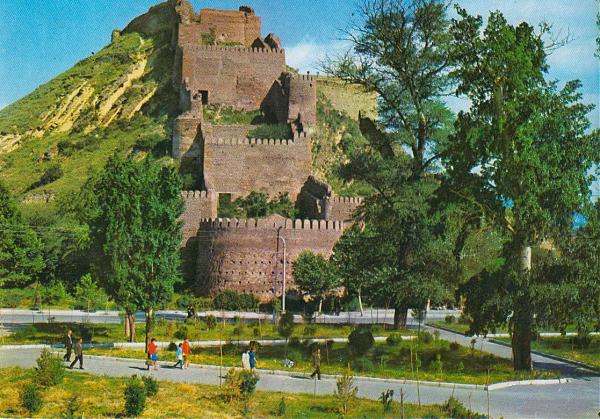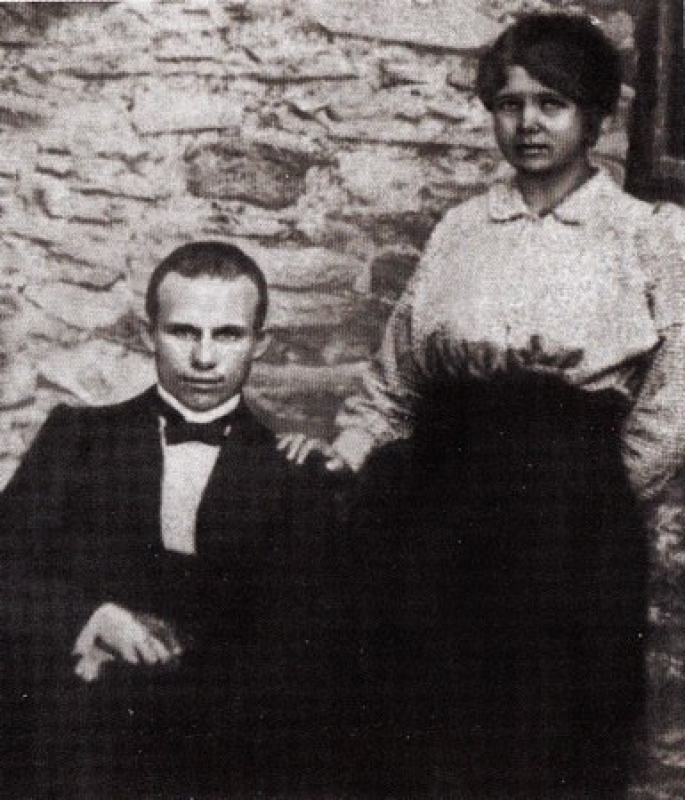|
Aleksi Inauri
Aleksi Inauri ( ka, ალექსი ინაური; , ''Aleksey Nikolayevich Inauri'') (May 12, 1908 – June 23, 1993) was a Soviet commander who headed the Georgian KGB (Committee for State Security) for over 30 years (1954–1986) and made it one of the most effective of the KGB's regional Soviet branches. Cherkashin, Victor & Feifer, Gregory (2005), ''Spy Handler: Memoir of a KGB Officer'', p. 125. Basic Books, . He ended his career as a colonel general and a Hero of the Soviet Union. Early life and career Born in Gori (then under the Russian Empire), Inauri was a worker until volunteering, in 1926, in the Red Army and graduated from a Cavalry School for the North Caucasian Mountainous Nationalities in Krasnodar in 1931. From April 1931, he commanded a cavalry platoon and then a squadron of the 16th Cavalry Regiment, 3rd Cavalry Division of the Ukrainian Military District. He became a member of the Communist Party of the Soviet Union in 1932. From October 1936, Inauri ... [...More Info...] [...Related Items...] OR: [Wikipedia] [Google] [Baidu] [Amazon] |
Gori, Georgia
Gori ( ka, გორი ) is a city in eastern Georgia (country), Georgia, which serves as the mkhare, regional Capital (political), capital of Shida Kartli. It is located at the confluence of two rivers, the Mtkvari and the Liakhvi River, Liakhvi. Gori is the List of cities and towns in Georgia (country), fifth most populous city in Georgia. Its name comes from the Georgian word ''gora'' (გორა), meaning "heap", "hill", or "mountain". A settlement known here from the Hellenistic period, with the Gori Fortress built at least in 7th century, it received town status in the 12th century. Gori was an important military stronghold in the Middle Ages and maintains a strategic importance due to its location on the principal highway connecting eastern and western parts of Georgia. In the course of its history, Gori has been invaded by the armies of regional powers several times. The city was Occupation of Gori, occupied by Russian troops during the 2008 Russo–Georgian War. Gori ... [...More Info...] [...Related Items...] OR: [Wikipedia] [Google] [Baidu] [Amazon] |
Major (rank)
Major is a senior military Officer (armed forces), officer military rank, rank used in many countries. When used unhyphenated and in conjunction with no other indicators, major is one rank above Captain (land), captain in armies and air forces, and one rank below lieutenant colonel. It is considered the most junior of the senior officer ranks. Background Etymologically, the word stems from the Latin word meaning "greater". The rank can be traced back to the rank of sergeant major general, which was shortened to sergeant major, and subsequently shortened to ''major''. When used in hyphenated or combined fashion, the term can also imply seniority at other levels of rank, including major general, denoting a low-level general officer, and sergeant major, denoting the most senior non-commissioned officer (NCO) of a military unit. The term major can also be used with a hyphen to denote the leader of a military band such as in Pipe-Major, pipe-major or drum-major. Links to major ... [...More Info...] [...Related Items...] OR: [Wikipedia] [Google] [Baidu] [Amazon] |
Nikita Khrushchev
Nikita Sergeyevich Khrushchev (– 11 September 1971) was the General Secretary of the Communist Party of the Soviet Union, First Secretary of the Communist Party of the Soviet Union from 1953 to 1964 and the Premier of the Soviet Union, Chairman of the Council of Ministers (premier) from 1958 to 1964. During his tenure, he stunned the communist world with his denunciation of his predecessor Joseph Stalin and embarked on a campaign of de-Stalinization with his key ally Anastas Mikoyan. Khrushchev sponsored the early Soviet space program and presided over various domestic reforms. After some false starts, and a Cuban Missile Crisis, narrowly avoided nuclear war over Cuba, he conducted successful negotiations with the United States to reduce Cold War tensions. In 1964, the Kremlin circle Nikita Khrushchev#Removal, stripped him of power, replacing him with Leonid Brezhnev as the First Secretary and Alexei Kosygin as the Premier. Khrushchev was born in a village in western Russia. ... [...More Info...] [...Related Items...] OR: [Wikipedia] [Google] [Baidu] [Amazon] |
Georgian Orthodox Church
The Apostolic Autocephalous Orthodox Church of Georgia ( ka, საქართველოს სამოციქულო ავტოკეფალური მართლმადიდებელი ეკლესია, tr), commonly known as the Georgian Orthodox Church or the Orthodox Church of Georgia, is an autocephaly, autocephalous Eastern Orthodox Church, Eastern Orthodox church in full communion with the other churches of Eastern Orthodoxy. It is Georgia (country), Georgia's dominant religious institution, and a majority of Georgian people are members. The Orthodox Church of Georgia is one of the oldest churches in the world. It asserts Apostles in the New Testament, apostolic foundation, and that its historical roots can be traced to the early and late Christianization of Iberia and Colchis by Andrew the Apostle in the 1st century AD and by Saint Nino in the 4th century AD, respectively. As in similar autocephalous Eastern Orthodox Christian churches, the chu ... [...More Info...] [...Related Items...] OR: [Wikipedia] [Google] [Baidu] [Amazon] |
Anti-Sovietism
Anti-Sovietism or anti-Soviet sentiment are activities that were actually or allegedly aimed against the Soviet Union or government power within the Soviet Union. Three common uses of the term include the following: * Anti-Sovietism in international politics, such as the Western opposition to the Soviet Union during the Cold War as part of broader anti-communism. * Anti-Soviet opponents of the Bolsheviks shortly after the Russian Revolution and during the Russian Civil War. * Soviet citizens (allegedly or actually) involved in anti-government activities. History In the Soviet Union During the Russian Civil War that followed the October Revolution of 1917, the anti-Soviet side was the White movement. During the Interwar period, some resistance movements, particularly in the 1920s, were cultivated by Polish intelligence in the form of the Promethean project. After Germany's attack on the Soviet Union in 1941, anti-Soviet forces were created and led primarily by Nazi Ger ... [...More Info...] [...Related Items...] OR: [Wikipedia] [Google] [Baidu] [Amazon] |
1956 Georgian Demonstrations
The 1956 Georgian demonstrations, also known as the March 1956 events or the Tbilisi riots, were a series of protests against Nikita Khrushchev's de-Stalinization policy which took place in Tbilisi, capital of the Georgian SSR, Soviet Union, and other cities in the republic from 4 to 10 March 1956. The immediate trigger was the publication of Khrushchev's " Secret Speech" which criticized Joseph Stalin, the former Soviet leader born in Georgia. The demonstrations began as spontaneous gatherings to mark the third anniversary of Stalin's death but evolved into large-scale protests, primarily led by students, defending Stalin's legacy and expressing Georgian national pride. Initial demands focused on retracting criticism of Stalin and acknowledging the anniversary of his death. However, as the protests grew and faced official opposition, demands became more radical, including calls for the removal of Soviet leaders like Khrushchev and Anastas Mikoyan, the rehabilitation of Stalin ... [...More Info...] [...Related Items...] OR: [Wikipedia] [Google] [Baidu] [Amazon] |
Lieutenant General
Lieutenant general (Lt Gen, LTG and similar) is a military rank used in many countries. The rank traces its origins to the Middle Ages, where the title of lieutenant general was held by the second-in-command on the battlefield, who was normally subordinate to a captain general. In modern armies, lieutenant general normally ranks immediately below general (or colonel general) and above major general; it is equivalent to the navy rank of vice admiral, and in air forces with a separate rank structure, it is equivalent to air marshal. In the United States, a lieutenant general has a three star insignia and commands an army corps, typically made up of three army divisions, and consisting of around 60,000 to 70,000 soldiers. The seeming incongruity that a lieutenant general outranks a major general (whereas a major outranks a lieutenant) is due to the derivation of major general from sergeant major general, which was a rank subordinate to lieutenant general (as a lieutenan ... [...More Info...] [...Related Items...] OR: [Wikipedia] [Google] [Baidu] [Amazon] |
Carpathian Military District
The Red Banner Carpathian Military District (, ) was a military district of the Soviet Armed Forces during the Cold War and subsequently of the Armed Forces of Ukraine during the early Post-Soviet period. It was established on 3 May 1946 on the base of the 1st Ukrainian Front, 4th Ukrainian Front, and Lviv Military District. It became part of the Armed Forces of Ukraine in 1991 and was disbanded by being redesignated the Western Operational Command in January 1998. History Two districts were formed in what was to become the district's territory in 1944 and 1945. During May 1944 in the freed territory of the West Ukraine the Lvov Military District was formed, headed by the former deputy commander of the 2nd Ukrainian Front. On 9 July 1945 the Carpathian Military District (PrikVO) was ordered created from the headquarters of the 4th Ukrainian Front in Chernovtsy. under the command of former front commander Army General Andrey Yeryomenko. It was responsible for troops on ... [...More Info...] [...Related Items...] OR: [Wikipedia] [Google] [Baidu] [Amazon] |
131st Separate Motor Rifle Brigade
The 131st Separate Motor Rifle Brigade () was a motorised infantry unit of the Soviet Army and of the Russian Ground Forces. The division traced its lineage back to the formation of the 1st Kursk Infantry Division in 1918 during the Russian Civil War. The division was redesignated as the 9th Rifle Division in October of that year, and fought as part of the Southern Front against the White Armed Forces of South Russia from late 1918 to early 1920. In late 1920 it fought in the Perekop–Chongar Operation, completing the defeat of the remaining White forces in Crimea, after which it participated in the Red Army invasion of Georgia in early 1921. The division was stationed in Georgia after the end of the campaign, guarding a sector of the Soviet border with Turkey. In late 1921 it was broken up into two separate rifle brigades, which were combined into the 1st Caucasian Rifle Division in 1922. The division was converted into a mountain unit in 1931, and was renumbered as the 9th Mo ... [...More Info...] [...Related Items...] OR: [Wikipedia] [Google] [Baidu] [Amazon] |
416th Rifle Division
The 416th Rifle Division was formed for the first time as a standard Red Army rifle division late in 1941, after the Soviet winter counteroffensive had begun, but was soon re-designated. A second formation began in March 1942, this time as an Azerbaijanis, Azerbaijani National Division and was completed in July, after which it remained serving in the southern sectors of the Soviet-German front until the autumn of 1944, when it was redeployed to Poland in anticipation of the final offensives into the German heartland. The 416th compiled a record of service comparable to any majority-Russian unit, and saw postwar service in the Group of Soviet Forces in Germany. 1st formation The first 416th Rifle Division began forming on December 9, 1941, in the Moscow Military District. Its primary order of battle was as follows: * 1368th Rifle Regiment * 1373rd Rifle Regiment * 1374th Rifle Regiment * 1054th Artillery Regiment The division was still forming up on January 27, 1942, when it was re ... [...More Info...] [...Related Items...] OR: [Wikipedia] [Google] [Baidu] [Amazon] |



